






BY EMMA CLEMENT Graphics Editor & Layout Co-Editor
Members of the Quinobequin Student Front For Palestine set up tents outside the George Sherman Union Monday late afternoon to protest the killing of Palestinian journalist Anas Al-Sharif and Boston University’s investments in companies supporting Israel.
Over 30 protesters with the QSFP gathered in front of the George Sherman Union and set up an encampment with a large banner, signs, music and tents around 5 p.m. They disbanded around 8:05 p.m.
Shortly after the encampment began, around one dozen BU and Boston police officers spread out around the protestors and locked the GSU doors facing Commonwealth Avenue. By the time the group disbanded, there were at least 25 police vehicles lining Comm. Ave. from the GSU to the College of Arts and Sciences.
The group rejected the GSU’s name, saying it was “named for a wealthy Boston robber baron.” FRIDAY,
They “renamed” the area the “Anas Al-Sharif Union” after a martyred Palestinian journalist, according to a statement posted to QSFP’s Instagram. The new name will create a “microcosm of a world that is possible,” the statement reads.
“We will transform this space into a base for struggle, collective education, and resistance against the institutions that fund, legitimize, and profit from genocide,” QSFP wrote in the post.
QSFP listed four continued demands in the post: financial divestment, boycotting complicit institutions, amnesty and reinstatement for students and staff and Immigration and Customs Enforcement off the University’s campus.
Students and staff gathered around the area at the sight of protesters and police presence.
Senior Victor Pelatere, who witnessed the event, said he was “so proud” the encampment was in a visible location.
“For us to be able to say something out loud about an ongoing genocide, about an absolute slaughter, that they are telling us to not believe with our very eyes, is empowering,” Pelatere said.
At 7:10 p.m., a QSFP speaker
BY TAVISHI CHATTOPADHYAY Associate City Editor
Nonprofits across Massachusetts have been thrust into financial turmoil amid broad slashes to federal funding, leaving their leaders scrambling to keep organizations afloat.
Afrimerican Academy, a Boston-based educational program serving underprivileged communities, lost its funding this week. The cuts ended the organization’s long-running summer and school year programming, said Marlon Solomon, senior project engineer and founder.
The nonprofit, which relies
heavily on city and state funds, prides itself on forging long-lasting connections to its students. However, funding cuts will shutter their school youth program and terminate projects students have been working on for years, Solomon said.
“I always say that you can do whatever you want to me, but when the kids get affected, that’s when it really bites,” Solomon said.
A series of executive orders and actions cutting federal funding have also led to the cancellation or pause of grants supporting nonprofits across the country.
addressed the crowd.
“Gaza has been made small by the Israeli occupation forces,” the speaker said. “We are showing the people of Gaza that we stand with them, with our own tents, with our banners, with our signs.”
Around 7:49 p.m., QSFP posted, “Admin and police are already threatening to descend on our students.”
Massachusetts State Police were witnessed on the scene around 8:00 p.m. Around the same time, a BUPD officer spoke on a megaphone saying protesters needed to immediately leave the area.
“If you do not immediately disperse, you will be arrested,” the officer said.
Junior Sophia Orr said the police reaction to the protesters made her feel “uneasy.”
“I think other students can definitely agree that the way [BUPD officers] swarm a peaceful protest definitely makes us a little bit uncomfortable, especially with the current state of ICE and current police interactions with the public,” Orr said. “I don’t think this was their best way to go about it.”
Freshman Andrea Kellerman said the encampment makes her feel “horrible” as a Jewish student.

“I believe in free speech, but not blocking a dining hall and making other students feel unsafe,” Kellerman said.
BU administration has been seen at the site telling students not to enter the encampment, according to QSFP’s Instagram story.
“It really is a moment to reflect on our freedom of speech, on our freedom to protest, on our freedom to say what’s right and from wrong,” Pelatere said.
Tavishi Chattopadhyay, Phoebe Miller and Jenny Chen contributed reporting.
BY KARYNA CHEUNG Investigative Editor
Boston University faculty and staff reported requests from administration to remove public-facing pride flags in recent weeks, which the University said is part of an effort to enforce the school’s signage policy across its three campuses.
BU’s chapter of the American Association of University Professors informed faculty in an email sent Monday that the Women’s, Gender and Sexuality Studies Program and the University’s Children’s Center received directives over
the weekend to remove their pride flags. The chapter later received confirmation that some removal requests “had gone on longer” than this past week, said BU AAUP Co-President Mary Battenfeld.
WGS Program Director Susanne Sreedhar said she received an email request Aug. 19 to move a pride flag, positioned in the window of the department’s sitting room in 704 Commonwealth Ave., to an “interior wall.” The request — which came from within a CAS planning and operations department — claimed the
Continued on page 7
Boston activists push for clean energy in urgent fight for planet

PAGE 6
Massó ¡Con Salsa! International Music Festival

Is higher education worth its price tag anymore? | Editorial

BY ELIZABETH MEHLER Campus Co-Editor
The aftermath of the assassination of conservative political activist Charlie Kirk has prompted wider discussion over free speech rights among students and staff at Boston University across the political spectrum.
BU College Republicans issued an open letter to BU President Melissa Gilliam on Sept. 10, urging a campus-wide protection of political discourse and a crackdown on violent speech.
BUCR President Zac Segal and Vice President Philip Wohltorf,
who both signed off on the letter, wrote that Kirk’s murder “struck at the principle he championed most: free speech.” They also expressed concerns for the rights of conservative students on campus.
Sophomore Rachel Rose, a member of BUCR, said there is an “attempt at indoctrination” in her classes.
“I can’t tell you how many classes I have been in where the professors assume that every single person in that classroom thinks the way that they do,” Rose said. “In fact, they make fun of the other side, and they degrade the other side.”
Nathan Phillips, a professor in the Department of Earth and
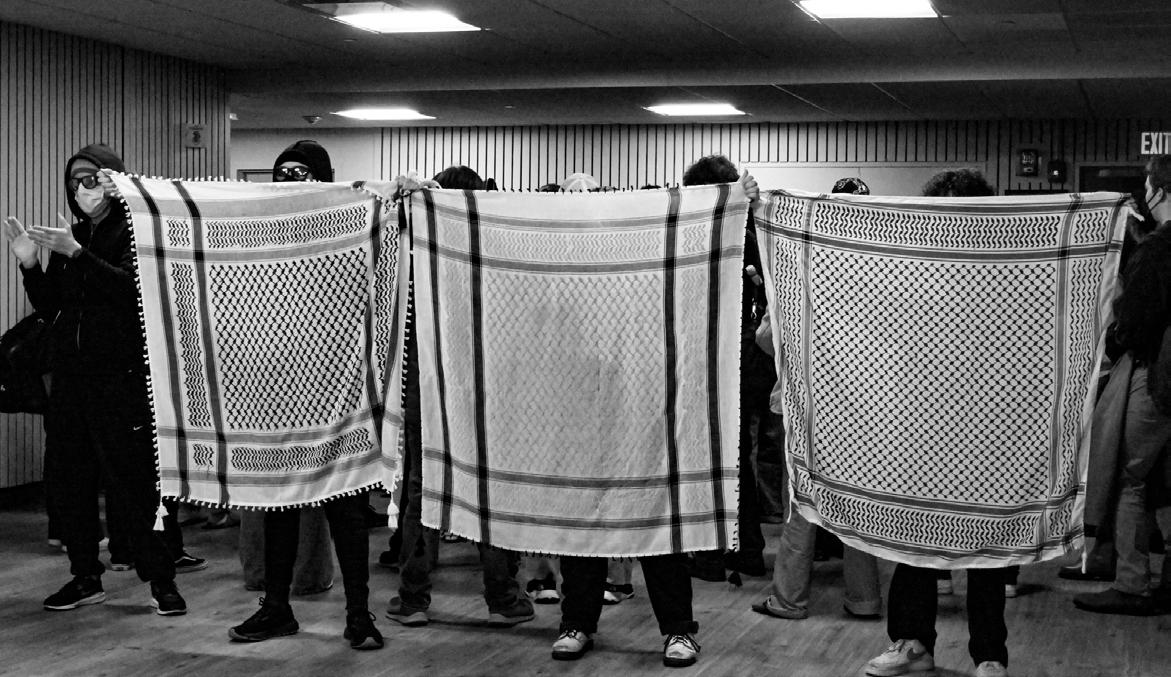
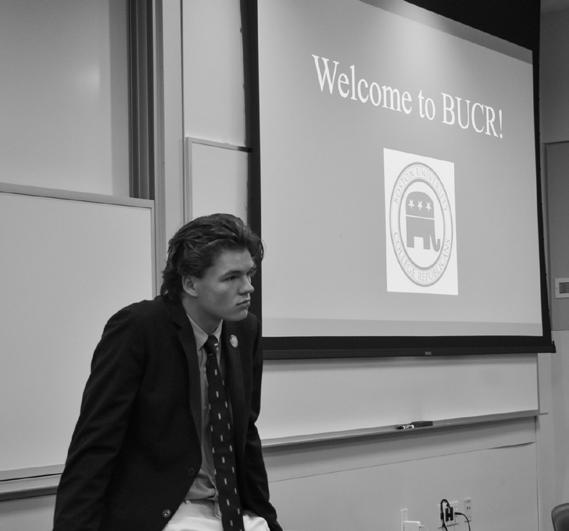

Environment, said he does not ridicule or silence the speech of students in his classroom.
Phillips, who has been involved in political activism on campus and in the greater Boston area, said he is careful not to bring his politics into the classroom.
“I’m very politically outspoken. I know that, but I think there’s a difference between doing that on Marsh Plaza versus doing it inside a classroom where it’s a captive audience,” he said.
He added he’s witnessed social change — in terms of dissenting political groups’ agendas — come from students, who, for example, introduced him to inclusive pronouns.
“The students were developing the social change, and they were bringing it into the classroom,” Phillips said. “Now, it’s spread to the overall university community. It did not come from faculty or administrators. It came from the students.”
Wohltorf pointed to a 2023 study conducted by the Harvard Crimson, which found that 9% of Harvard professors identified as conservative. The same is likely at BU and other elite universities, Wohltorf said, which causes conservative students to hide their beliefs.
Taylor Boas, chair of the BU Political Science Department, said the department values “diversity of political opinions and the freedom and the comfort to express those.”
“We certainly don’t aim to indoctrinate anyone,” he said.
As department chair, Boas is responsible for fielding student complaints. In his three years as chair, Boas said a student has “never” reported they felt their grade was “influenced by ideological or political bias.”
Divya Gummuluru, a sophomore studying international relations, said she questions BUCR’s claim that conservative students face “academic penalty” for their viewpoints. She finds it “pretty unrealistic” that conservative viewpoints would result in docked
points on an economics test, for example.
“But if you’re discussing homophobic or transphobic or racist things, I would understand why you’re getting points taken off. At that point, that’s not a politics debate, that’s just genuine empathy,” she said.
BUCR member Rose said her conservative viewpoints have been “isolating” on campus.
“When people hear that you are a Republican, they don’t want to talk to you,” she said. “There is an assumption about who you are without ever getting to know you.”
Segal said he’s faced similar social repercussions for being an active member of BUCR.
“It was only really towards the end of last year that I even told my friends that I was involved in the club, that I was conservative, and as a result I lost a lot of friends,” he said.
However, concerns about suppressing free speech on campus are shared by more than just rightleaning students.
Both Back Bay Young Democratic Socialists of America and Quinobequin Student Front For Palestine were suspended within the last year for campus demonstrations and ultimately chose to disaffiliate from BU.
The office space the two groups used to meet and organize — the Center for Gender, Sexuality and Activism — closed in August, following an incident of vandalism last spring, and was replaced with an administration-controlled space.
Additionally, senior Mary Haddad was recently suspended for one year for allegedly assaulting a police officer last semester in a student demonstration demanding BU’s divestment from Israel.
Senior Gretchen Fuller, president of BU College Democrats, said it’s “hypocritical” of BU administration to punish students for their activism.
“The BU administration holds up people like Howard Thurman and Martin Luther King Jr. and their legacies of nonviolent civil
disobedience and then punishes students for doing that same thing,” she said.
This upcoming Monday, BUCR’s executive board is meeting with Gilliam. The group received security from the BU Police Department at their last Monday meeting, which takes place weekly.
“It does feel like [BBYDSA and QSFP’s] free speech is being denied,” Gummuluru said. “I really do think that it goes to show the difference in treatment.”
Phillips said he faced similar suppression from BU administration for his activism in the spring, when political signs in his office window advocating for the release of people abducted by ICE were taken down by BU facilities.
“BU was very disingenuous, and they did not show a commitment to freedom of political speech,” Phillips said.
The suppression of his speech and other left-leaning groups on campus is likely being done to avoid becoming a target of the Trump administration, Phillips said.
“It’s clear they want to stick their heads in the sand and just hope the Trump problem goes away, hope that BU avoids the spotlight,” he said. “This is a bad strategy, to stick your head in the sand, shut your mouth and hope the problem goes away. It’s coming for all of us.”
Despite administrative interference, activism for Palestine on campus continues. QSFP held an encampment in front of the GSU Monday, and BBYDSA held a priority setting meeting off campus Wednesday.
BUCR also plans to continue expressing their views and hopes to make their organization more accepted.
“I hope that moving forward, we can be a real voice on campus, and people don’t have to lie about where they’re going when they come to a meeting on a Monday night,” Segal said.
BY AVERY FOX Senior Writer
AND VERONICA HERNANDEZ DFP Writer
Boston University was recently ranked as the No. 1 safest college campus after dark in a new study, according to NBC Boston.
The study, published by home investor group PPS Homebuyers, considered data on factors such as crime, walkability, lighting and late-night resources for 100 colleges and universities across the country.
BU received a safety score of 73 out of 100, the highest among the schools analyzed.
BU Police Department
Lieutenant Daniel Healy cited the “dedicated police department,” the trust built between officers and the community and the BU alert system for BUPD’s success in keeping the campus safe.
“We’re always trying to put our best foot forward for this community,” he said.
The study found that BU has nearly half the national average for campus crime rates, and its local crime rate is about 30% lower than other college towns. The study also scored BU’s campus an 83 out of 100 for walkability.
BUPD was “glad to hear” its work to make campus safe was being recognized, Healy said.
“There’s a whole department
of men and women that are committed to providing a high level of services for Boston University,” he said. “We have over 50 sworn officers that are ready to respond if someone’s in need.”
BU Spokesperson Colin Riley said safety on campus is a priority to BU administration.
“We’re very pleased to see that our work is recognized … because safety and security is the most important thing of our community,” Riley said.
Riley attributed campus safety to BUPD and the University’s Safety, Security and Preparedness team.
“It isn’t just protecting, but it’s also planning for how to respond or be prepared for any emergency situation, whether it’s weather or an accident or any other calamity that typically happens in an urban area,” Riley said.
Healy said BUPD is committed to building trust with the BU community to ensure students can rely on the department for oncampus safety.
BUPD ensures this by having a Public Safety Office, stationing officers in dorms, and “making sure people are comfortable to call,” Healy said.
“That’s how you continue to do a good job in this area,” he said. “If you don’t have trust with your community, you’re in trouble in this business.”
Sophomore Amelia Giese said last year, she would finish water
polo practices around 10 p.m. at the BU Fitness and Recreation Center and walk home 25 minutes to her dorm on East Campus.
“I’ve always felt very safe walking around on campus at night, which is pretty surprising because I am a young woman,” Giese said.
Giese said she was not surprised by the study’s results and is grateful for the University’s safety efforts.
“I know we have a very strong police presence from the BUPD, which I really appreciate,” she said.
Giese said having visible emergency resources nearby, specifically the emergency call boxes, helps her feel secure on campus.
Junior Lina Santos said she feels “very satisfied with safety” on campus because of the campus environment and location within Boston.
“Around Commonwealth [Avenue] … there’s a lot of dorms, a lot of students around,” she said. “So, this environment, which is somewhat isolated from the rest of the city, makes the institution safer.”
A key takeaway from the survey’s results is that BU community members play a role in maintaining campus safety, Riley said.
“When you see something is … wrong or potentially dangerous, you react to it,” he said. “We suggest the best reaction is to

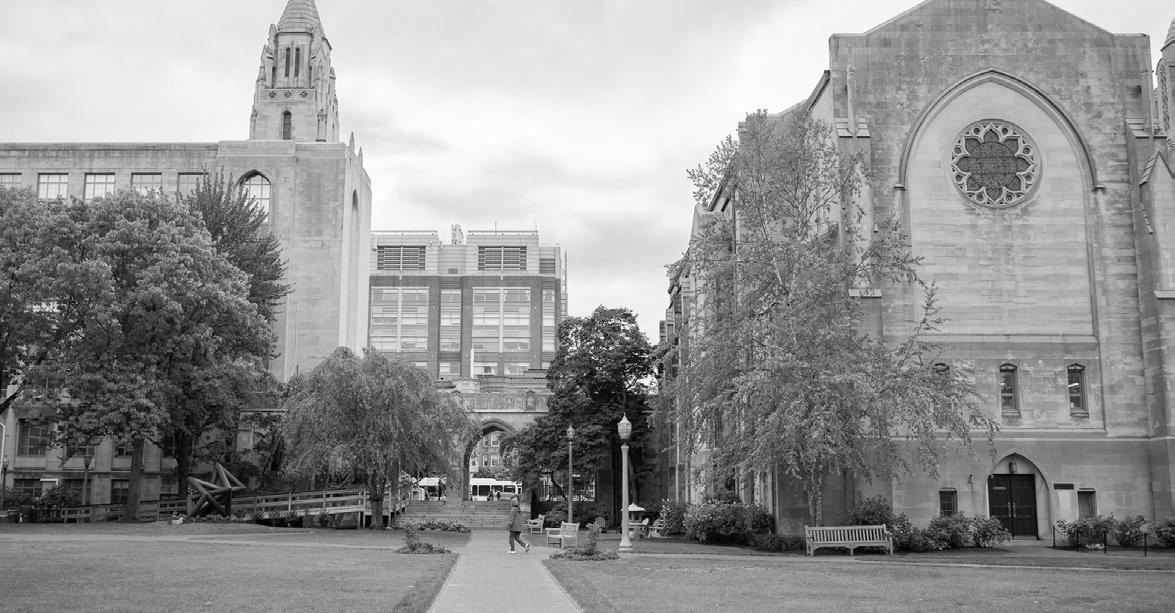
report it to somebody.”
Healy agreed that personal responsibility is important, noting the most common crime on campus is theft. He said students must pay attention and take “care of [their] personal property.” Healy said he recommends
students walk in groups, stay in well-lit areas and avoid using earphones at night to improve “situational awareness.”
“It’s so important for people to take some of that personal responsibility and try to help each other,” he added.
Continued from page 1
In Massachusetts, about 60% of government grant filers are prone to losing money when operating. In Suffolk County alone, a little over 63% of filers are at risk of not covering their expenses if they lose their government grants.
The United Teen Equality Center works with youth burdened by past criminal involvement and aims to “trade violence and poverty for economic and social success,” according to the center’s website. The non-profit receives about 60% of its revenue from federal and state government grants and contracts, said CEO Gregg Croteau.
In April, the Trump administration terminated 373 grants from the Department of Justice’s Office of Justice Programs. UTEC’s funding was subsequently slashed by about $2 million, after being denied the Community Violence Intervention grant program, Croteau said.
“These were grants from the Department of Justice [and] were critical for our work,” he said.
The Center has also attempted to appeal the DOJ’s decision to withdraw the grant program. However, updates on the appeal have yet to be given since its filing in May, Croteau said. It joined a group of other nonprofits that relied on the CVI grant in filing a lawsuit against the DOJ, which is currently being heard as an appeal in the circuit court, Croteau added.
UTEC served over 525 young adults in 2024. 71% of those enrolled in their programs had no new arraignments within the year.
“We’ve seen more investments, more recognition
of the work that street outreach workers do,” said Croteau.
“We’re just committed to making sure that folks know they’re valued. This work is valued.”
In the face of cuts, UTEC and Afrimerican Academy are seeking out alternative sources of revenue to keep their doors open.
Solomon said he plans to keep running the Academy’s cultural heritage tours while applying for private grants.
UTEC hopes to secure funding from private foundations and continued investments from the state, Croteau said.
“Moving forward, there’s clearly a level of uncertainty about how the reductions in Medicaid and SNAP benefits at the federal level will impact the state budget as well,” he said.
The One Big Beautiful Bill Act, signed into law by President Donald Trump in July, could rid about 40,000 Boston residents of their SNAP benefits and kick over 200,000 more off Medicaid.
“The federal government has been cutting back on spending that supports various human services programs,” said José Massó, City of Boston’s chief of human services. “We know that this inevitably will harm the most vulnerable members of our city.”
Massó said the city provides a handful of grant programs aimed at supporting nonprofits, including the Youth Development Fund and the Youth Sports Grant.
However, the widening gap in funding may be too big for the city to fill.
“There’s no way that the City can make up for the deep cuts that will be brought on by the decline in federal funding,” Massó said.


BY NICOLE ABRAMS AND SAANVI HARIDAS Associate Campus Editors
Since the U.S. Department of Homeland Security initiated Operation Patriot 2.0 Sept. 6, U.S. Immigration and Customs Enforcement officers have conducted a series of raids across
Boston neighborhoods.
This wave of raids follows
Operation Patriot, which resulted in 1,500 arrests statewide in May.
“Under President Trump and Secretary Noem, nowhere is a safe haven for criminal illegal aliens,” Tricia McLaughlin, the assistant secretary for public affairs, wrote in a statement. “If you come to our country illegally and break our laws, we will hunt
you down, arrest you, deport you, and you will never return.”
At a city council meeting Sept. 10, Councilor Liz Breadon condemned a parent being taken by ICE “in the vicinity” of Brighton High School while taking her child to school.
“Boston will not support these illegal attacks on our community nor will we be intimidated. As a community, we are working

together to provide for those in need at this time,” wrote Breadon in a statement to The Daily Free Press.
Along with Breadon, nonprofits across the AllstonBrighton district are grappling with ICE’s aggressive approach and its debilitating community impact.
Charlesview, Inc. is an organization based in the Allston-Brighton neighborhoods that offers affordable and mixed income housing to residents and community members.
“Because there was such an intensive amount of ICE raids in the spring, it was definitely traumatic for many folks,” said Jo-Ann Barbour, executive director of Charlesview. “Largely for families that have come from countries where that kind of response to people is something that they left their country because [of].”
In response to the rise in ICE raids, Charlesview runs training and information sessions out of its community center for residents and others in the neighborhood.
“We’ve done ‘Know Your Rights’ training, [and] there’s been ally training that we’ve let folks know about in the community,” Barbour said. “We’ve made sure that all residents understand it’s really important not to blindly let somebody come into the building.“
She emphasized the need for students to “speak up” against the raids and said students should receive the necessary education “to understand what is important in terms of being an ally.”
Some Allston-Brighton nonprofits are conducting interorganizational meetings to discuss the presence of ICE in the community and immigrantrelated services.
One such organization is the Allston-Brighton Health Collaborative, a nonprofit devoted to improving neighborhood health.
This community response came when fear within and threats to the immigrant community became palpable, said Nikhil Dasgupta, engagement and operations manager for ABHC.
“A lot of people in our community are not really feeling safe to leave their homes as much as they might otherwise,” he said. Dasgupta said ABHC provides resources to help immigrants learn more about their legal status and contact a lawyer. It is also restarting its food delivery network, which began during the COVID-19 pandemic.
“Our focus is on whether people in our community feel safe and happy and healthy,” Dasgupta said. “That’s why we respond with things like resource connections, food delivery, making people feel safer where we can.”
BY PARIS HUGLEY Contributing Writer
The College of Fine Arts has seen its fair share of bold colors, but few compare to the new exhibit that opened this fall.
Victor “Marka27” Quiñonez’s new installation, Ni de Aquí, Ni de Allá — which translates from Spanish to English to “Not From Here, Not From There” — is a new solo exhibition on view from Sept. 5 through Dec. 10 at the Boston University Faye G., Jo, and James Stone Gallery.
Quiñonez’s art primarily explores themes of biculturalism in relation
to his Mexican-American identity.
The exhibit, curated by the internationally acclaimed Kate Fowle, opened a little over a week prior to the beginning of Hispanic Heritage Month, which takes place Sept. 15 through Oct. 15.
“‘Not From Here, Not From There’ really encapsulates the bicultural, bilingual experience of growing up in the [United] States rather than in the place where your parents are from,” said sophomore Julian Rivera. “Of course, you’re going to preserve your culture … [B]ut at the end of the day, we’re all born in America.”
Through colorful imagery, Quiñonez merges cultural textiles and handwoven rugs with objects


from his childhood to tell stories of immigration and incarceration.
The exhibition’s pieces resonated immediately for senior David FilsAimé.

“The piece that got my attention the most was the popsicle stand that said ‘I.C.E. Scream,’” Aimé said. “Given the recent rise of [Immigration and Customs Enforcement]’s presence everywhere, I think that’s very powerful.”
Aimé said the installation’s details gave the work a warmth and depth, especially in a storefront-style piece called “Botanica.”
“It’s super intricate … [I]t seems super cozy, super warm, just looking at it,” he said. “His use of neon lights is very
captivating.”
Quiñonez, with his distinctive “Neo-Indigenous” style, draws from hip-hop, Chicanx aesthetics and graffiti background in his works. His murals crowd subjects with color and influence, honoring his personal experience and cultural history.
The exhibit’s meaning connects to larger questions of belonging on campus, sophomore Maria Reyes said.
“For many students, specifically immigrants, it can be easy to feel like you have to leave your culture behind,” Reyes said. “Being in Boston, it’s very easy to feel imposter syndrome.”
Having organizations on campus helps students adjust to being away from home and in a new cultural environment, Reyes said.
“I feel like it’s important to help students feel a sense of community, a sense of home, family, and it’s something to be proud of to have
BY SAM MANDALA Campus Co-Editor
The voices of the Extinction Rebellion Boston members protesting environmental destruction ring outside the General Hooker entrance of the Massachusetts State House. The activists have flyers in hand and are ready to approach whoever enters their eyeline.
Statehouse Standout, a protest initiative organized by XR Boston, takes place every Tuesday and Thursday from 10 a.m. to 2 p.m. and seeks to draw legislators’ attention to the climate crisis.
XR is a “decentralised, international and politically nonpartisan movement” relying on nonviolent civil disobedience to promote active change in legislation to address the climate and ecological emergency, according to the organization’s website.
“We aren’t living in a broken system. We’re living in a system
that is functioning exactly the way it was designed … to perpetuate the status quo that it is killing us,” said Jamie McGonagill, XR Boston’s media and messaging director. “Our job is to disrupt that status quo as much as possible.”
Since 2022, XR’s goal is to ban all new Massachusetts fossil fuel infrastructure.
“If your bathtub was full to overflowing, the first thing you would do is turn off the tap. You wouldn’t spend time leaving the tap running and mopping the floor,” said XR Boston member Peter Watson. “We would like to see any new fossil fuel development infrastructure stopped … and until that happens, the water’s still going to be spilling.”
For Watson, the war on climate is personal. In his 80s, Watson said he’s always hoped for grandchildren. After a conversation with his daughter, who decided she no longer wanted children because of the state of the world, Watson realized he never would.

“That woke me up to it, and I started paying attention and saw how really screwed up everything was,” he said. “Ultimately, if nothing is done, we don’t have much longer on this planet.”
It was the work of members like Watson at a demonstration at the Hanscom Airport that brought major success to XR Boston.
The Hanscom Airport Expansion — which proposed 17 new storage units for private jets — would have erased 70% of Massachusetts’ solar gains, McGonagill said.
Climate activists infiltrated the airport April 20, 2024, and shut down its operations. Police arrested 20 members, including Watson.
The proposal was subsequently sent back, and the legislation was reformed before it reentered the state congress.
“The power we have is in numbers, and if we don’t have the numbers, then we’re basically ceding all of our power to billionaires and politicians who are owned by billionaires,” said May, an XR Boston member who wished to withhold her last name for personal safety.
With members like May and Watson, the group will continue to show up no matter the circumstance.
In July, Watson had two heart attacks in the course of a week. The next week, he returned to work shifts on the protest line.
He remains one of the most active members in the organization, tabling and protesting for the past five years — back when the group was called “Green Bananas” and met in a tiny Cambridge apartment.
XR first launched in the United Kingdom in the fall of 2018, when a group of activists gathered to request immediate government action regarding the climate crisis. Within weeks, rebels had blocked five major bridges, glued themselves to Buckingham Palace
and dug a coffin on Parliament Square for humanity’s future, according to XR’s website.
The movement quickly spread internationally, with more than 992 groups in 88 countries currently. In the spring of 2019, Boston became one of the first chapters to start actively participating in the United States.
“It’s a classic Boston story. We were very early to adapt to the idea of revolution [and] very early to take action on a revolution.”
McGonagill said. “We remain one of the most engaged, one of the largest and one of the most established chapters in the country.”
XR Boston demands the government declare a climate and ecological emergency and “take immediate action to halt biodiversity loss and to reduce greenhouse gas emissions 90% by 2030,” according to its website.
There is an 86% chance the global mean near-surface temperature will exceed 1.5 degrees above the 1850-1900 average levels for at least one year between 2025 and 2029, according to the World Meteorological Organization. This violates the Paris Agreement, a legally binding international treaty on climate change, according to the United Nations.
“I’m worried about the future of the planet, and I’m worried even about our immediate future, within our lifetimes,” May said. “I’m here to try to get people motivated to fight against this and work for more sustainable energy.”
XR Boston will attend the Make Billionaires Pay protest in New York City Saturday to continue their work.
“It’s important for people to remember that the future is not written in stone, and that if we stick together and organize, we can make a better world for everybody,” May said.
these organizations on campus,” Reyes said. “They give everyone a chance to learn, connect and just celebrate together.”
She pointed to Festival Latino, a collaboration between Alianza Latina, and several other Hispanic student associations, as a highlight of Hispanic Heritage Month.
“One of my favorite parts is how it brings people together, and it can open new doors for people to meet other people on campus,” Reyes said.
The exhibit speaks to the value of preserving culture and community in today’s social climate, Rivera said.
“In the whole initiative of [pushback against] culture and inclusivity, it’s definitely necessary in places like these to have fun with people and just enjoy community with each other,” Rivera said. “Being able to have spaces like these is essential.”
BY MARY GOETZ Associate Community Editor
Stress ReLeaf: Obtaining Calm with Tea
Mondays through Dec. 1, from 4 p.m. - 5 p.m., 808 Commonwealth Ave.
At the LGBTQIA+ Student Resource Center, Student Wellbeing hosts a weekly workshop working with tea as a conduit for achieving mindfulness and calm.
Covet Consignment
$5 Bin Sale
Wednesday, Sept. 24, various locations
Show up to one of the store’s four locations — Beacon Hill, Back Bay, South Boston or South End — at 10 a.m. for a large selection of consigned clothing, shoes and accessories.
FensFest at the Fenway Victory Gardens
Saturday, Sept. 27, from 11:30 a.m. - 3 p.m., 1200 Boylston St.
Attend FensFest, a celebration of community and gardening where attendees can enjoy live music, food trucks and the fall day, located in the Fenway Victory Gardens.
Read more about these events, and others like them, on The Daily Free Press website Monday, Sept. 22.
BY EMMA CLEMENT Graphics Editor & Layout Co-Editor
Less than 10 minutes from Boston University’s Charles River Campus, between the Back Bay, Kenmore and Fenway neighborhoods, is a small, unassuming park underneath the Bowker Overpass. For years, the space was underutilized — but now, each Sunday from 10 a.m. to 2 p.m., the park comes alive with food, music and community for the Charlesgate Farmers Market.
From June 22 to Oct. 12, the weekly market serves as a space for the community to enjoy live music and converse with their neighbors as they shop the week’s vendors.
Jon Sautter, a TV commercial producer from Fenway, said he and his wife go to the market “every week, rain or shine.”
“This is the only place we shop,” Sautter said. “It’s not only [that] the level of quality of food is superior to the grocery store, even the Whole Foods, but it’s also the community that you
find.”
Caroline Reeves, founder and director of Charlesgate Farmers Market, opened the market under the Muddy Water Initiative, an environmental advocacy and action group dedicated to keeping the Muddy River and surrounding areas clean.
Reeves said her goal with the project was to transform a dull, abandoned park into a vibrant community space.
“This space has been abandoned and [an] eyesore and a nuisance for the 30 years that I’ve been living here,” Reeves said. “It’s a real problem for our neighborhood, and I thought somebody needs to activate this space, and I thought, ‘We are that somebody.’”
Now in its second season, the Charlesgate Farmers Market has become a community staple.
“It’s like a real big community event every Sunday, [and] it’s hard to find that in a lot of neighborhoods,” Sautter said.
The market has 29 vendors, who sell products ranging from fresh produce to dog treats.

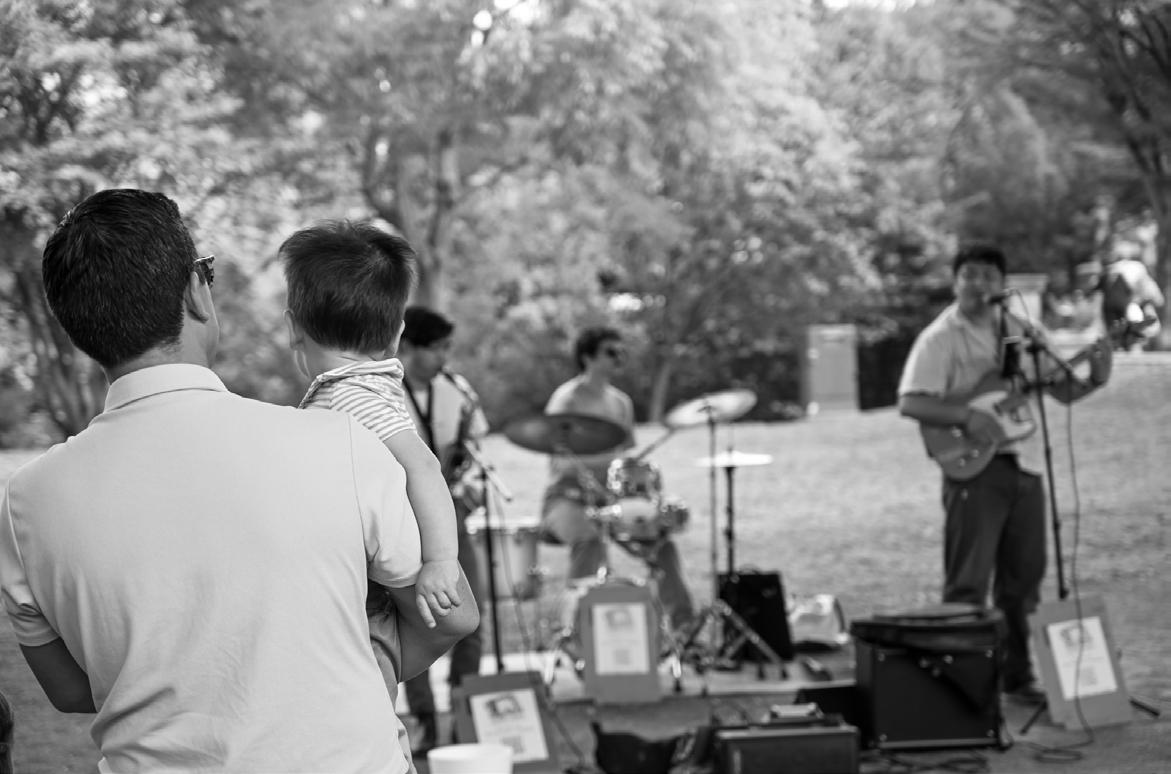
microgreens and leaf lettuce at the market for two weeks.

John Mara, who helps run the farm from “behind the scenes,” said it grows more than 75 varieties of fruits and vegetables.
Dick’s Market Garden, a family-owned farm founded in 1944, with over 260 acres of land in Lunenburg, Massachusetts, is the only fresh produce vendor at the Charlesgate Farmers Market.
Over 95% of what Dick’s sells at its farmstand is grown on the farm and generally picked fresh the day before it’s sold, Mara added.
“It’s really a group that’s dedicated to attending on a weekly type of basis and [the person who manages the stand has] made sure he brings in the variety that we grow every single week, so people are seeing everything that is available,” he said.
As one of the larger businesses at the Charlesgate Farmers Market, Mara said he hopes Dick’s Market Garden can help bring in business to the other vendors.
“We’re hoping that by being the large produce vendor, that people are coming and seeing what we have and then helping the other vendors out,” Mara said.
In addition to well-established businesses like Dick’s Market Garden, the market also hosts a variety of up-and-coming businesses.
The Florist’s Daughter, a joint venture of Adelle Bonavire and her daughter, is in its first season with the market.
Bonavire said she and her daughter have provided flowers for events such as weddings and baby showers, but the market has allowed them to branch out and bring more attention to their business.
“The people here are so nice,” Bonavire said. “The vendors change up all the time, so it’s good to meet new people, and everyone that comes through has just been super supportive.”
Wendy and Mark Donohue also own a small business featured at the market — a hydroponics company called Leaf Water Farms.
Hydroponics is a plantgrowing technique that uses a water-based nutrient solution as an alternative to soil, yielding more crops while requiring less space and water.
The couple founded the business just a few months ago and have been selling
Wendy said they found success offering samples to customers because many people are unfamiliar with microgreens.
“You don’t know until you try it how good they are,” she said. “It feels really good when someone takes a little bite, and they’re like, ‘Oh wow, it tastes really good,’ and then they buy something.”
For Bonavire, the ability to experience products with all five senses is a big appeal of farmers markets, she said.
“Everything today is so ondemand online,” Bonavire said. “I feel like the Farmers Market is just such a great way for people to sample things, buy things, talk to people [and] have a conversation.”
Reeves said she is ultimately proud that she and her team have been able to transform the park into a lively community space.
“When I drive by the market on a Sunday, and I see the colors, hear the music, you can see the people at the table, the dogs, I’m proud,” Reeves said. “I’m really genuinely proud that we have created a space that works for the neighborhood.”
BU experts warn RFK Jr.’s CDC firings threaten public health, point to local scientists for guidance
BY BRIAN CHAN Associate Science Editor
The Centers for Disease Control and Prevention, a division of the U.S. Department of Health and Human Services, has long been a trusted source of vaccine recommendations and policy. However, over the last several weeks, a series of changes have made many skeptical of the agency.
Robert F. Kennedy Jr., secretary of HHS, fired CDC Director Susan Monarez in August after she challenged his orders to fire scientists and sign off on vaccine policies prior to reviewing their respective research studies.
Earlier this year, Kennedy fired all 17 members of the Advisory Committee on Immunization Practices, a federal advisory committee that provides evidence-based recommendations on vaccine use for U.S. citizens. Kennedy has appointed 12 new members as of Sept. 15.
Matthew Motta, an associate professor at the Boston University School of Public Health, said it appears Kennedy made these decisions to align health policy with his political views instead of basing them on a scientific consensus.
“[The new ACIP members]
are certainly people who share Kennedy’s views about the science, and Kennedy believes very strongly that his views represent the best available science,” Motta said.
Timothy Callaghan, associate professor at SPH, said people traditionally look to the CDC for public health advice.
If the CDC begins to provide inaccurate information, Callaghan noted, there will be a decrease in public trust. This may lead people to rely on alternative sources of information, such as social media influencers, he said.
Motta said public confusion will make fighting infectious disease threats more difficult.
“There are plenty of Americans who right now would love to get an updated COVID-19 shot, who aren’t sure that they’ll be able to because pharmacies aren’t sure that they should have this vaccine on hand, and they’re not sure if their insurers will ultimately pay for it,” he said.
Various states have begun implementing their own guidelines in response, Motta said.
For instance, Massachusetts Gov. Maura Healey announced Sept. 4 that states across New England and the Northeast will collaborate to adopt the evidence-based approach the federal government has stepped away from.
“We’ve never seen states break from the CDC en masse in the way that they are right now,” Motta said. “This, to me, is something that is very new.”
Although the consequences from the splintering of vaccine policy are unknown, Motta predicted vaccination rates could lower in coming years.
However, he said Massachusetts’ autonomy from CDC guidelines protects its residents from federal changes.
Callaghan recommended that those living in Massachusetts refer to local experts for advice on the prevention of infectious diseases.
“We have some of the world’s most prominent experts in immunology and vaccine science, in infectious disease control, living right here,” he said. “Listening to those experts who are knowledgeable about keeping us safe and keeping us healthy here at home would be a smart practice.”
Motta and Callaghan are the co-directors of the Politics and Health Lab, a research group dedicated to tracking and stopping the politicization of public health.
Callaghan said the lab has found that vaccine skepticism at the CDC is part of a trend of antivaccine sentiment and legislation following the COVID-19 pandemic.
“We’ve seen a massive growth in political polarization in this country over the past several decades,” he said. “And in the past five to ten years, it has culminated in not just influencing politics but influencing health.”
Sophomore Neveah Robles said she feels there needs to be more of a separation between politics and science.
“Politics is more of an opinion on what people want,” she said.
“Science is proving whether a vaccination is actually helpful.” For such a separation to occur, Motta said politicians — regardless of their partisan status — need to show they agree on the science of how to prevent and counter disease.
“If policymakers will only start to make more of an effort to show themselves taking action to protect all of us, then I think the public will follow suit,” he said.

BY RACHEL FEINSTEIN
Associate Photo Editor
Community artists and activists came together on Sept. 13 for Boston’s Embrace Massó ¡Con Salsa! International Music Festival to showcase the rich diversity of Latin traditions and rhythms. This year marks the 50th anniversary of community leader José Massó III’s bilingual Afro-Latin music program on WBUR, “¡Con Salsa!”. Mayor Michelle Wu honored him at the festival.
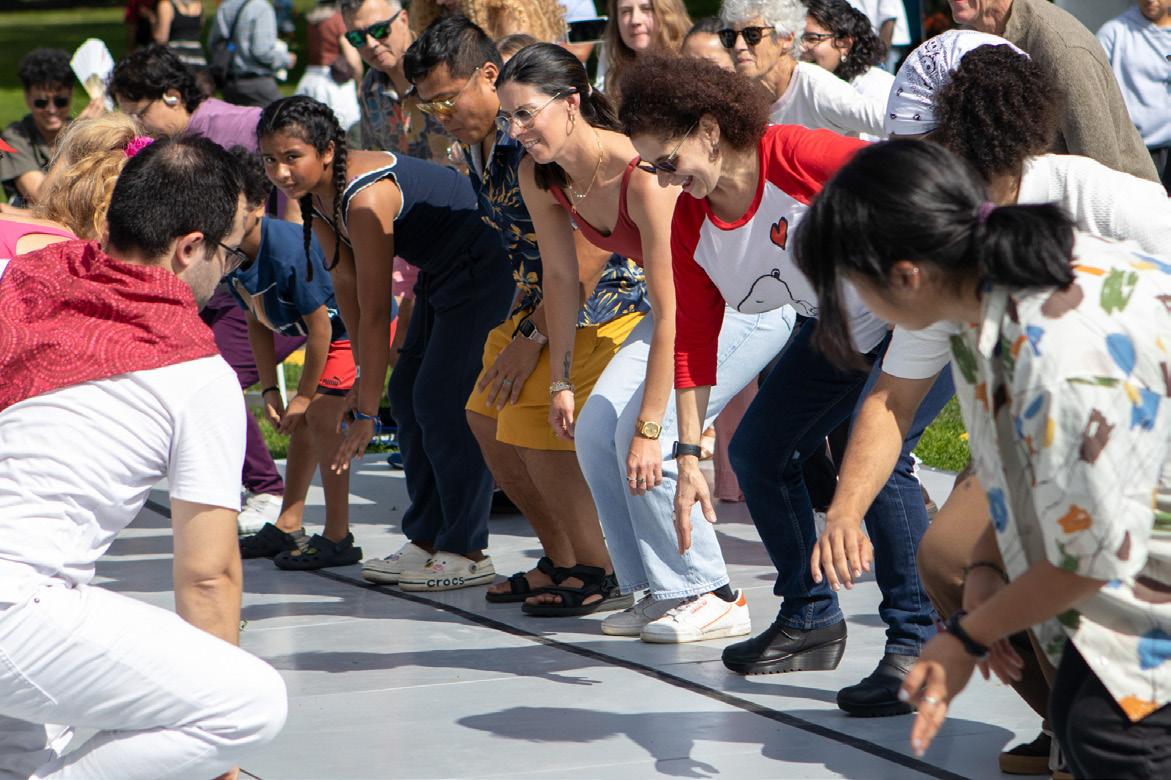


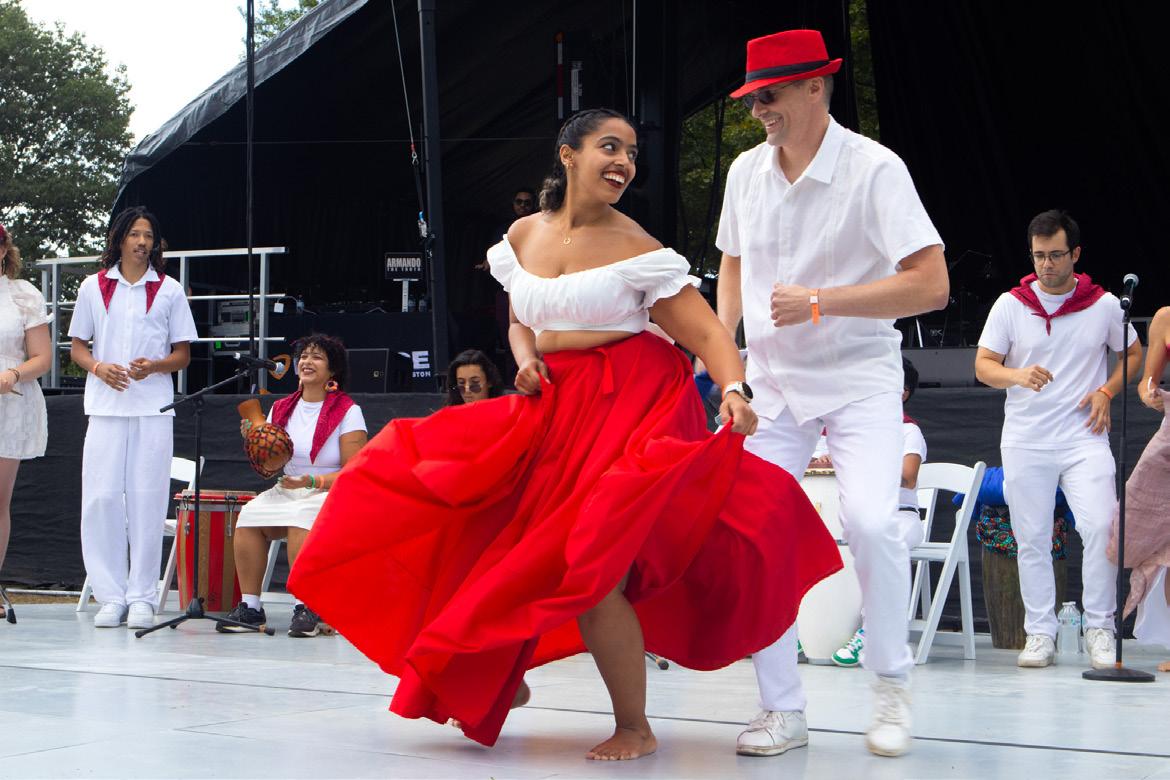
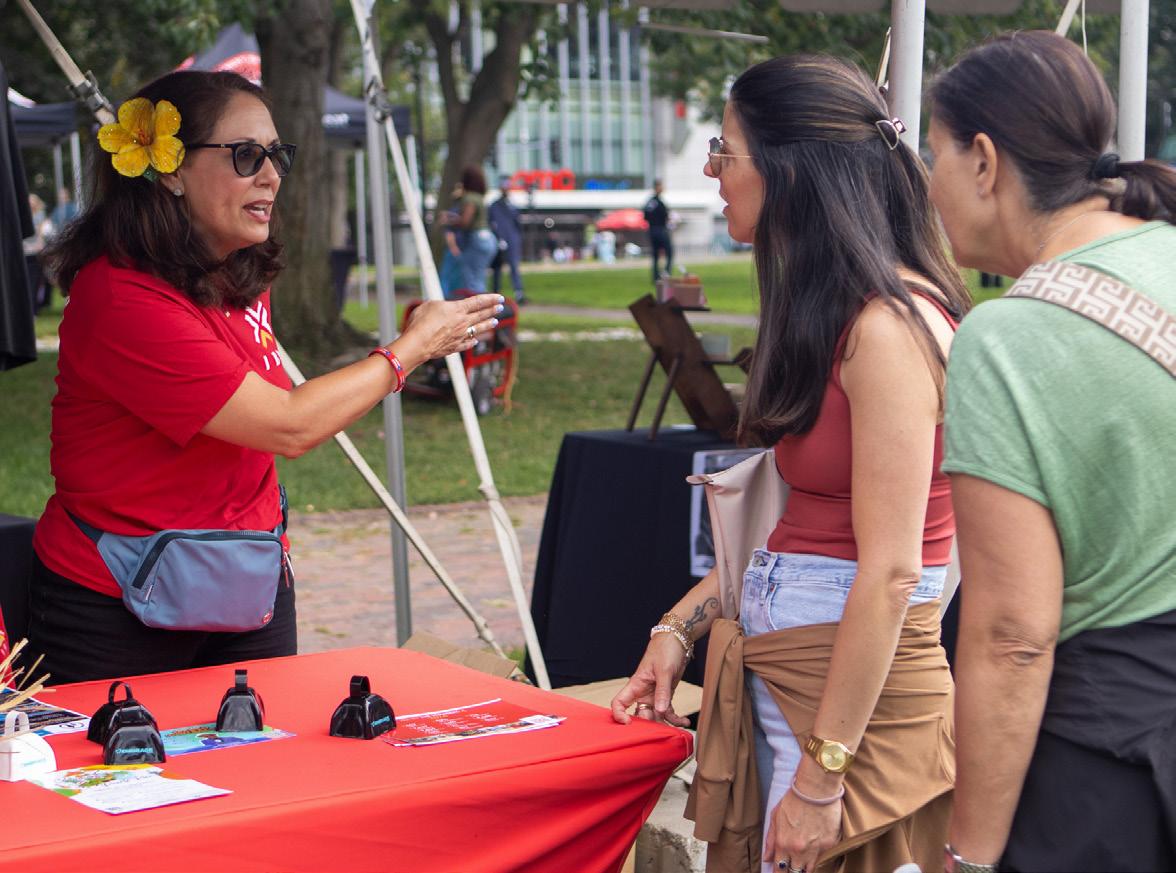
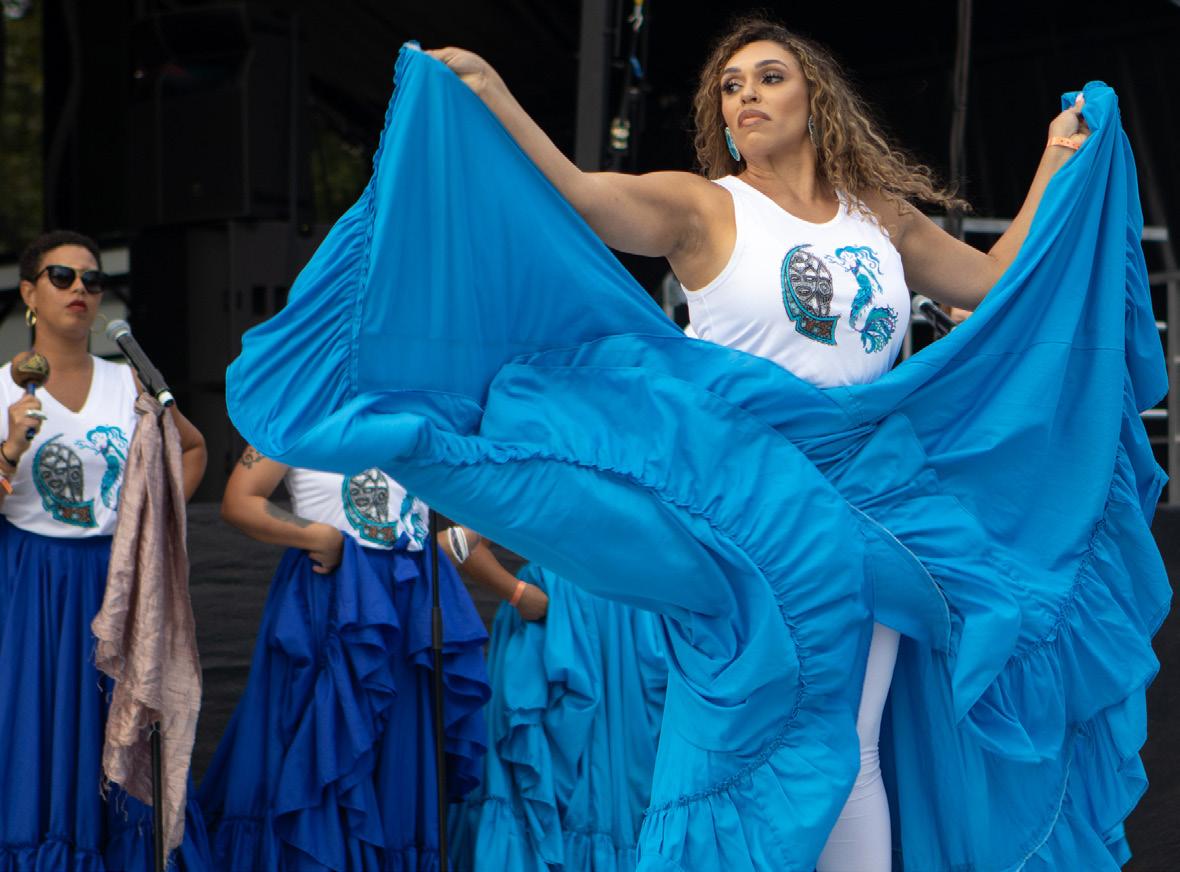
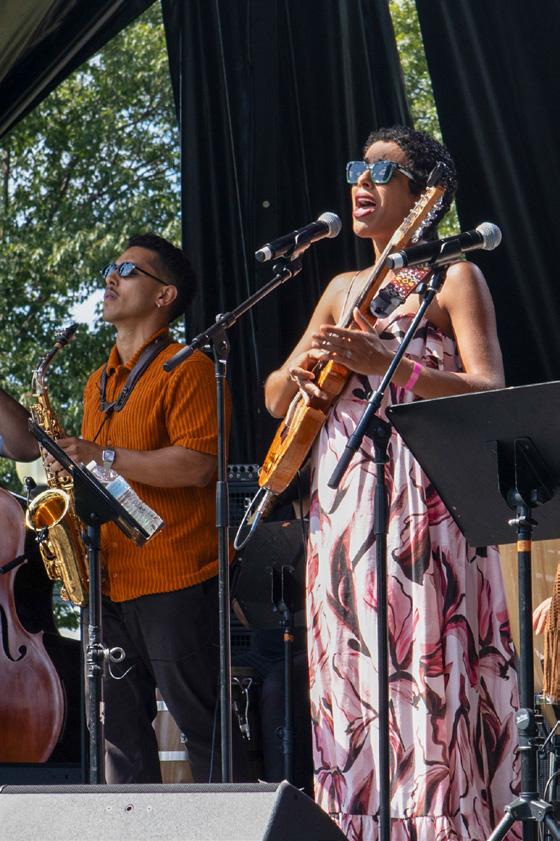
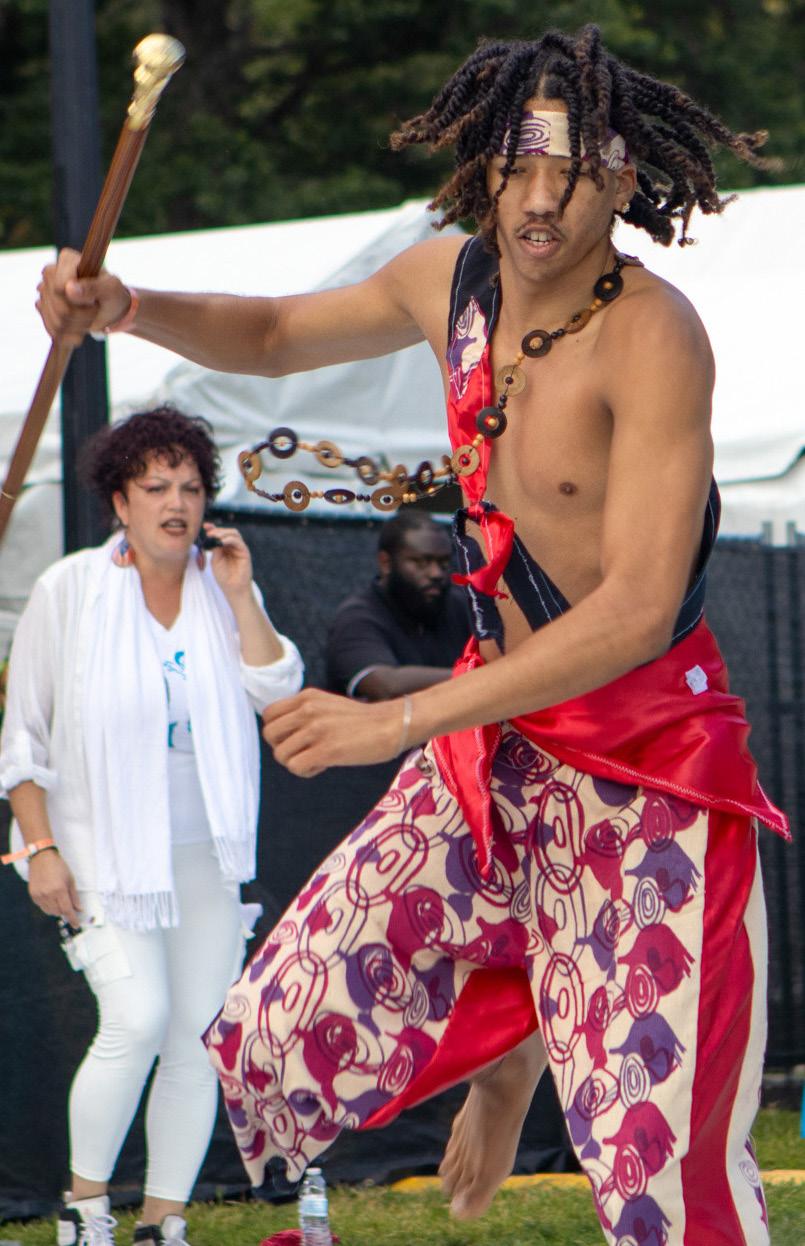


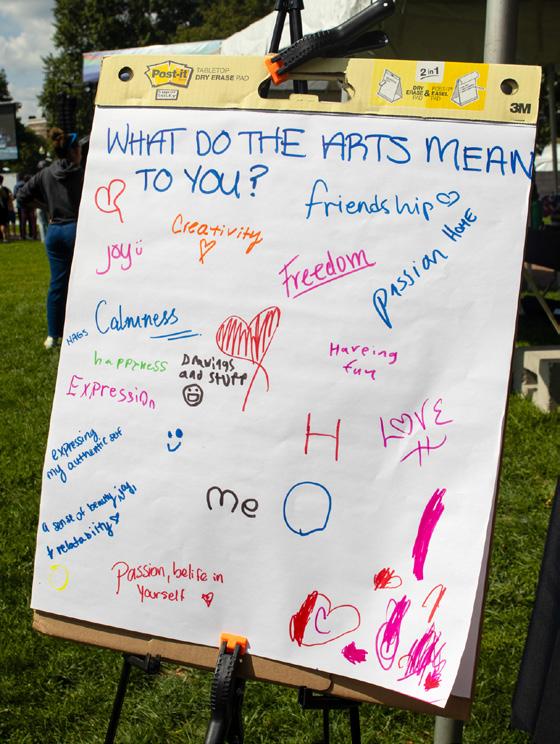

BY JENNY CHEN Layout Co-Editor
AND AVA RUBIN
DFP
Photographer
Members of the Quinobequin Student Front For Palestine protested the killing of Palestinian journalist Anas Al-Sharif and Boston University’s investments in companies supporting Israel outside of the George Sherman Union on Sept. 15. A heavy BU and Boston police presence responded. The protest followed the suspension of BU senior Mary Haddad and a pattern of pro-Palestine protests in the spring.


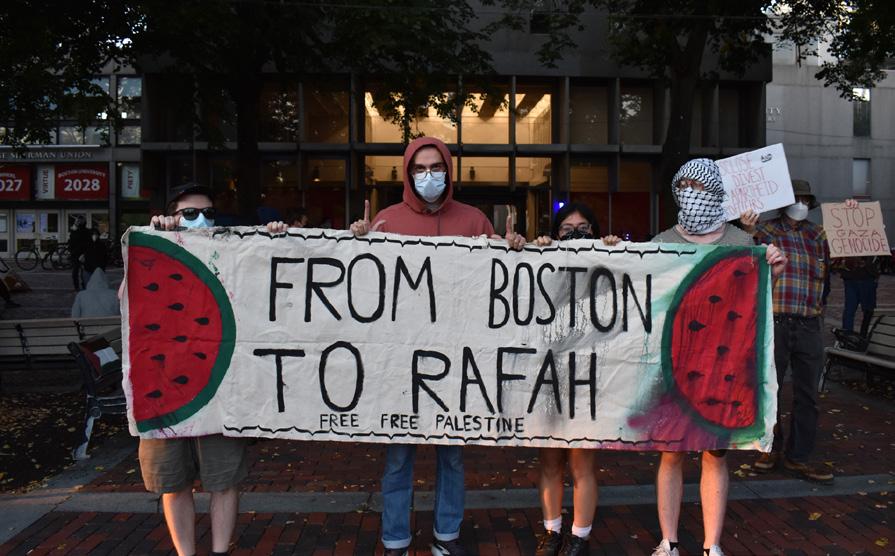




Continued from page 1
flag violated signage rules listed in BU’s Events and Demonstrations Policy, Battenfeld said.
The signage policy, which BU Spokesperson Colin Riley characterized as “longstanding,” states that unattended placards, banners or other signs are not permitted unless they are affixed on a previously approved location, including “Free Expression Boards” on campus.
“Any signage used by Event participants may not be affixed to any University-owned property, including walls, windows, or furniture,” the policy states.
BU President Melissa Gilliam announced updates to the Events and Demonstrations Policy in a letter addressed to the university community on Sept. 17, 2024. The update altered a student-specific policy on signage to apply on a university-wide scale. The current policy is a result of those changes.
“We’re a welcoming and inclusive community,” Riley said. “It is not about the posting, it’s the location.”
Sreedhar said she had never heard of BU requesting faculty or staff to take down “something like a pride flag” prior to the recent request. She perceived it as an infringement of free speech,
Sreedhar added.
“I was very surprised that this is something that happened in the current political climate by this institution that I thought prided itself on not just freedom of expression but inclusivity, especially of queer folks,” Sreedhar said.
After consulting with WGS faculty, Sreedhar opted not to relocate or remove the flag. A week later, she received a message asking for confirmation that the flag had been removed. She last
corresponded with Associate Dean of Social Sciences Arianne Chernock Sept. 9 to dispute the request, who told Sreedhar she would follow up with her on next steps.
“It seems like a violation of free speech and free expression,” Sreedhar said.
“Given BU’s commitment to diversity, equity and inclusion, as spelled out in the Strategic Plan, which specifically mentioned the LGBTQ population, we feel like the pride flag is an important

signifier.”
Sreedhar also noted she had seen flags and signs posted around campus in unapproved areas in previous semesters, including signs celebrating new graduates and an Israeli flag in a window of the Florence and Chafetz Hillel House on campus.
The signage policy had previously not been “uniformly enforced,” Riley said, resulting in the replacement of some postings that were initially removed. He added that removal requests were being made across campus in multiple offices and locations.
The Daily Free Press reported multiple incidents in Spring 2025 where Nathan Phillips, a professor in the Department of Earth and Environment, claimed political signs he posted in his office window were removed without warning.
“It’s a longstanding policy, and we expect people to abide and comply with university policies,” Riley said. “If [people] are not familiar with them, they may not be aware, and [the policies] need to be communicated. So this academic year is an effort to be consistent to communicate that.”
Battenfeld said LGBTQ students and staff are targeted by the Trump administration’s executive orders cracking down
on diversity, equity and inclusion programs. She believes these federal initatives are the reason the University is implementing the policy now.
“Higher administration seems to be operating under the premise that you hide your head, and the Trump administration won’t notice you,” Battenfeld said.
She also heard BU would be issuing a “no flags” policy soon.
The Daily Free Press has been unable to confirm if the University will be issuing a “no flags” policy in the future.
The Daily Free Press reached out to several professors with ties to the University’s DEI efforts, all of whom could not be reached or declined to comment and one who requested anonymity for fear of retribution.
“[My answers] could be misconstrued as disparaging to the U.S., especially since my comments will be in the public domain,” the anonymous professor, who is at BU on a scholarship visa, wrote in an email. “As much as I would like to share my views, I am going to have to reluctantly decline.”
The BU Children’s Center, the childcare facility for young children of faculty, staff and graduate students, declined to comment for this story.
BY ELYSE BLOOM DFP Columnist
I’m embarrassed to say there have been times in the recent past where I’ve seen a video on TikTok and thought to myself: “Is this real, or is this AI?”
I truly could not discern the difference.
When the video’s content is “Real or Cake?,” I do not ponder too long on whether the cake was truly made by a baker or not. But when the video is news — a depiction of the war in Gaza, for example — I become a bit more concerned.
According to the Pew Research Center, 54% of Americans report
they consume at least some news from social media sources. These sources include anything from YouTube and Instagram, all the way to X and Truth Social.
More than half of TikTok users report that they regularly consume news through the app — myself included. This statistic has more than doubled in the last four years, when in 2020, only about 20% of TikTok users used the app for information on current events, according to surveys conducted in by the Pew Research Center.
During the pandemic and postpandemic period, TikTok turned from a short-form video app home for viral dances to a place where an alarming proportion of Gen Z users consume their news.
The Reuters Institute reported that traditional media sources have been declining rapidly in the last few years, replaced with the growth of news consumption on social media platforms.
Over half of the people surveyed by the institute “remain

concerned about their ability to tell what is true from what is false when it comes to news online,” according to Reuters. Now more than ever, it is absolutely imperative to be equipped with the skills to tell the difference between real and fake news.
The most common fake news offenses include — but are certainly not limited to — clickbait accounts, internet trolls and online bots, according to a journal article published in 2022 by the National Library of Medicine. All of these types of accounts have a high incentive, monetary or not, to attract users to fake news articles.
In a day and age where more traction on your page means more money in your pocket, a flashy article title can produce real, tangible profit — which is exactly why we need to be careful about the reliability of the news we consume.
Most recently, in the age of AI, anything can be made to look like real news. Even if AI offers citations for its answers, users are too busy to fact-check AI itself, leading to the wildfire-like spread of fake news.
However, I am not here to argue that we need to take down social media news reports or completely stop our reliance on social media for news.
There are some clear benefits to social media as a news source — as long as it’s not the only source — that are commonly brushed over.
Social media can be a great outlet for uncensored news. News was spread almost instantaneously about the shooting of conservative political influencer Charlie Kirk on Sept. 10 through both traditional and nontraditional news channels.
However, while mainstream news outlets were reporting that Kirk remained in “critical condition” for hours after the shooting occurred, social media reports publicized his death far quicker.
The first official word of Kirk’s demise came from none other than President Donald Trump himself — but not through White House reporting. Trump took to Truth Social, his own social media creation, to break the story.
In a world where the president personally reports news through a social media app, there is a clear line demarcating the news of the past and our new era of social media reporting.
Further, social media brings attention to important issues that private news corporations may avoid or be hesitant to report on.
Journalists are being persecuted and killed for their work, such as with the murder of Al Jazeera correspondent Anas al-Sharif. In light of this persecution, citizen journalism can compensate for gaps in information.
When war broke out in Gaza in the wake of the attacks Oct. 7, 2023, the greatest pieces of information showing the reality of the destruction in Palestine came from ordinary people with cellphones and TikTok accounts.
While everyone needs to tap into factchecked, accredited news sources, there is also plenty of news out there that is well reported on peer-to-peer levels.
Each and every one of us who wants to remain an informed, worldly citizen of the modern era needs to find our own healthy mix of news sources to provide the broadest scope. And maybe make sure to throw a couple of AI-generated cake videos in between, just for fun.
The presence of AI in the job application process has become increasingly prevalent. Companies are using AI to make the hiring and onboarding process more efficient, as it allows them to assess a large volume of candidates and arrive at decisions at a significantly faster rate than before.
According to a survey by the New York State Society of Certified Public Accountants, 68% of job firms are planning to use AI in their recruitment process by the end of 2025.
The survey conducted in October 2024, in which 948 business leaders participated, discovered that 82% of companies use AI to review resumes, and 23% use AI to direct interviews. However, 76% of firms will employ AI to ask interview questions by 2025.
Resumes and cover letters, which hiring recruiters once had to read and manually sort for hours on end, are now analyzed by AI scanners programmed to search for keywords and phrases to determine a candidate’s eligibility.
This has significantly decreased the value of one’s resume, which at one point was one of — if not the most — important components to an application and now is merely an entry point to get through AI before receiving human contact.
The increase in AI use is not only occurring on the hiring side of the job market. Roughly 65% of applicants utilize AI at some point in their application process, according to a study by Career Group Companies. Such functions range from giving general career advice to tailoring resumes based on specific job descriptions and requirements to incorporating keywords into resumes.
One could assume that a significant amount of today’s job application process is AI communicating with other AI.
Today, recent post-graduates struggle for extended periods of time to find employment despite higher education, which at one point posed a significant advantage in the job search process.
A recent report from Oxford Economics found that young adults in the United States have a 6% unemployment rate — 1.8% higher than the national average. This is the first time in 45 years that data has reported a higher unemployment rate for young, college-educated individuals than the national average.
For those who are employed, there are greater nuances to this employment that may not be apparent to the naked eye. More than half of American Gen Z graduates
There are also recent graduates who enter the workforce in jobs that do not match their primary or prior training.
This struggle for employment among young, college-educated adults is in part due to a disproportionate number of available workers compared to the limited number of open jobs.
The advancement of AI is also reducing entry-level jobs that recent grads with limited experience likely would fill. Since January 2023, there has been a 35% decrease in the number of job postings for entrylevel positions. A lack of entry level jobs contributes to the disparity in available young workers to open job positions.
Today, one might assume that the rising cost of college is indicative of
all the time: networking. Today, higher education buys you access to a network of well-connected professors, industry professionals and likeminded motivated individuals who may aid you in the future. Networking — for those who don’t have nepotism — has become almost vital for those who want access to competitive jobs and internships.
According to Forbes, career experts estimate 70-80% of all open job positions are a part of the “hidden” job market that can only really be accessed through networking or internal employee referrals.
While higher education may no longer be the golden
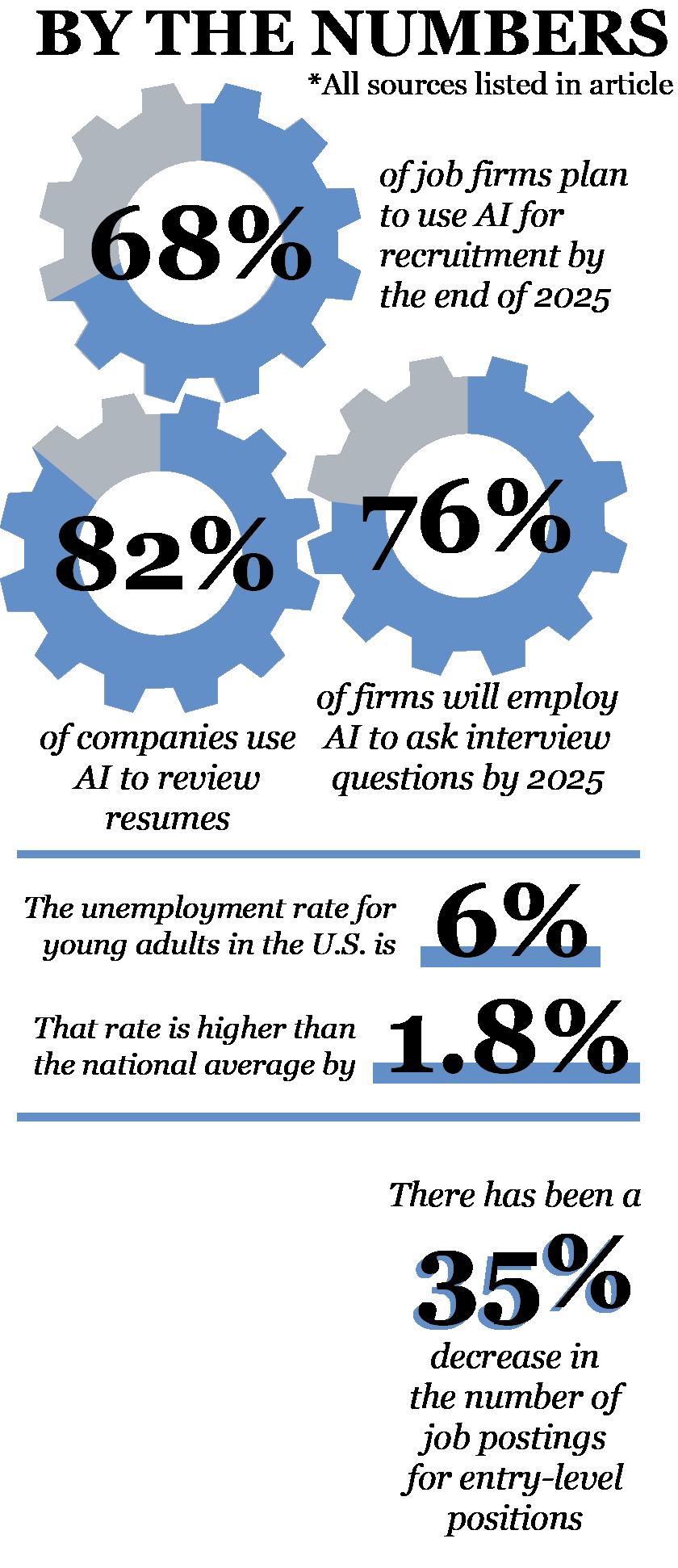


YEAR LVI. VOLUME A. ISSUE II.
Published Friday, September 19, 2025.
The Daily Free Press is published Sunday through Thursday during the academic year, except during vacation and exam periods, by Back Bay Publishing Co., Inc., a nonprofit corporation operated by Boston University students. Copyright © 2025 Back Bay Publishing Co., Inc. All rights reserved.
Lauren Albano, Editor-in-Chief
Samantha Genzer, Managing Co-Editor
Crystal Yormick, Managing Co-Editor
Sam Mandala, Campus Co-Editor
Elizabeth Mehler, Campus Co-Editor
Liam Dunne, City Co-Editor
Leia Green, City Co-Editor
Karyna Cheung, Investigative Editor
Kailyn Smith, Sports Editor
Sophie Shatzky, Arts & Community Editor
Jack Schwed, Business & Science Editor
Anjola Odukoya, Opinion Co-Editor
Ada Sussman, Opinion Co-Editor
Erica Schwartz, Lifestyle Editor
Josie Kalbfleisch, Photo Co-Editor
Isabella Oland, Photo Co-Editor
Emma Jee, Master of Games
Mia Kitaeff, Multimedia Editor
Andrew Lay, Podcast Editor
Jenny Chen, Layout Co-Editor
Emma Clement, Graphics Editor & Layout Co-Editor
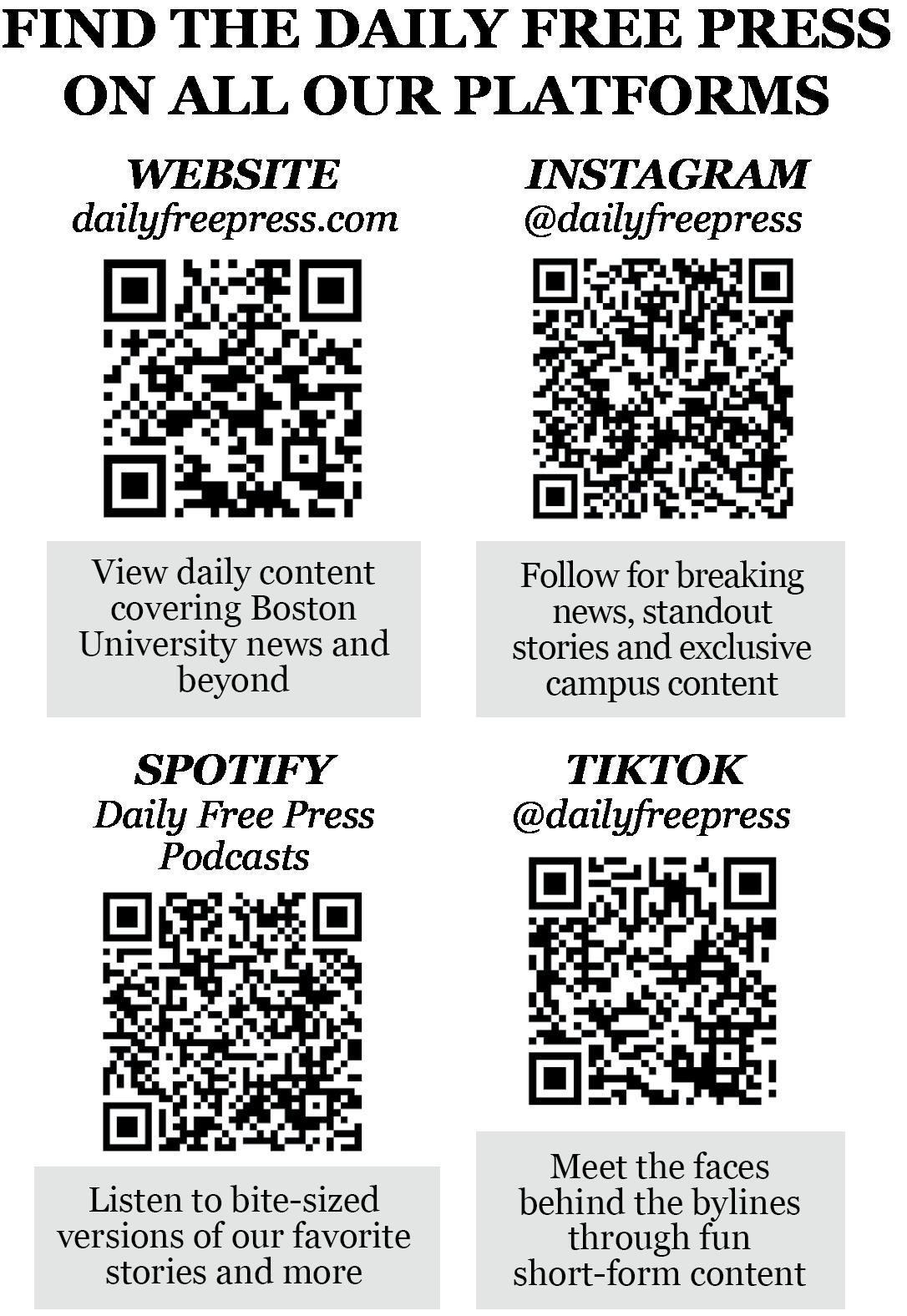

1. Erode
7. Laptop of choice for many BU students
10. Met___ (BU ballroom)
14. Retired Spirte
15. ___ carte
16. COM 101 Professor David
17. Evoke, as a response
18. X-ray scans
19. BU Shakespeare production?
20. Smell or sight, for example
21. Washed-up person, say
23. The “E” in FreeP E-Board?
26. 2016 Vine meme: fr e sh ___
29. Cream-filled pastry
33. Moved quickly, as in cross-country
34. Sound from Big Ben
36. Jojo Siwa song
37. What 808 Gallery displays
38. Drum sound in BU Pep Band
41. Choose
42. Popular spring break locale
44. “Les Miserables” novelist
45. View
46. Anticipate
48. ___ Hornsby,
alum in “The Hate U Give”
50. Popular backpack brand for college students
53. Imaginary
55. Beyonce can see these in her third album?
59. Salmon shade
60. Major brownstone locale, abbr.
61. Jot down
62. Desire
63. Fair-hiring letters
64. Intellectual
65. BU’s community resource dog
66. Newbury and Beacon, on a mailing address
67. Senior
1. Enzyme endings
2. Liver fluid
3. Pull (in)
4. Inverse of the reciprocal of cos
5. Dehydrated fruit variety
6. What you might do to 5-Down
7. Ultra-masculine
8. Wedding setting
9. Sydney Sweeney in “Euphoria”
10. With the circled letter, what Aural Fixation and
BassLine do
11. Competent
12. Tilt
13. Pants part
22. September 3rd, for BU students
24. Thought 25. Follows exactly
26. Kelp used in Japanese cuisine
27. Swollen vein
28. BU group with clicking footwear?
30. Got up
31. Set in motion
32. Badger’s cousin
35. Common Southeast Asian slang
39. Nickerson Field surface
40. Water, in Mexico
43. Author of “The American Language”
47. Teams on BU Survivor
49. “Please be ___”
51. Family room appliance
52. Subs
53. Let go
54. ATL location?
56. “Oh shoot, I’m going to be ___!”
57. Singer Redding
58. Religious subgroup
59. Dining option found in BU’s Castle
61. Massachusetts to Maine dir.
BY NINO MACHAVARIANI Associate Lifestyle Editor
“The Summer I Turned Pretty” aired its last episode of the final season on Sept. 17, marking the end of an era.
A lot of us, especially those who began watching in high school and transitioned into college, felt like we grew up with the characters and all the messiness in their lives.
Personally, the show felt almost ritualistic to watch during the summer. As the main character Isabel “Belly” Conklin would put it, my life was measured in summers, especially with the stress of reality. The show was a way to decompress.
Luckily, even though the television series ended, the story continues: Prime Video officially confirmed a follow-up movie. However, it won’t be released for some time. So let’s discuss what we just witnessed in the meantime.
Let’s begin with the most coveted topic before the airing of the final episode: Belly’s bob.
I’ve heard some complaints about her new styling making her look older, but isn’t that the point? There was a time jump, people grow up and you can’t be the innocent girl in love with your childhood forever.
She definitely wasn’t the same old Belly when she put on that black dress with the red lip. That was the cherry on top — quite literally.
And on the topic of styling, oh, hello Conrad. The look of Christopher Briney, the character’s actor, was top-tier with loosely undone button-ups, tailored pants, classic loafers and his signature watch that screamed quiet luxury. He served Alain Delon in “Purple Noon,” strutting among us mortals and gracing us

with his angelic presence.
I am giving the two mains the spotlight on this one, but I must note the rest of the cast looked amazing as well. There was an air of put-togetherness that was previously lacking.
As a die-hard Conrad apologist, I admit Jeremiah cleaned up well after his father cut him off. There is something about selfdevelopment that makes anyone look good, and his attempt to figure things out without people’s help was attractive.
Then the birthday dinner, the parallels and the undeniable tension between Isabel and Conrad the entire episode were
bone-chilling.
Jenny Han, you will always be the queen of literary devices.
I am talking about the buildup of Bonrad’s love through flashbacks spanning from childhood to adulthood.
One scene — a punch in the gut — takes place in Paris, when Isabel’s French friends are passing around a blunt, and she turns to Conrad, saying, “Do you memorize like every single thing I’ve ever said?”
And the crowd gasps again. Because that is exactly what Conrad asked her in the first season when she was swimming in the pool, being watched by
him. Absolute cinema right there.
When Belly then took Conrad to her favorite spot by the river under the moonlight, it was a sight worth screaming for.
The two of them dancing close to each other for the first time in years and all the feelings pooling back in — could a romantic ask for anything else?
Then, when he asks her, “And have you moved on?” She looks at him, in the way she always has, with love spilling out of her gaze, and that is all it took for the flame to be lit: the kiss.
At this point, I was jumping up and down and having heart palpitations.
After a few deep breaths and reminders that this isn’t real, I was brought back to reality — and apparently so was Belly.
Because what did she pull after Conrad and she finally got together? She told him she was unsure whether she really loved him after this golden man flew across the Atlantic for her.
To be fair, she really needed time away from men, and having him come in, ushering all of the emotions back into her was scary.
With just five minutes left in the episode, and an unresolved Bonrad ending, the heart palpitations came back.
But thank God for Jenny Han representing all of our romantic fantasies, because Belly did end up running after Conrad after all — in a very European romance film fashion, I may add.
Speaking of Europe, the cinematography definitely changed to adopt more of a vintage romantic lens.
The visuals, with their subtle grain, really brought out that old love story vibe and tied up the styling, location and emotions well.
Then, Taylor Swift’s “Out Of The Woods” began playing, marking a full circle moment in which Belly goes after what she truly wants for the first time in her life.
Even as I write this, not even 24 hours after watching the episode, I still feel the electricity.
This final episode truly is the end of an era. How else am I going to live out my dreams of finding a Fisher boy now? Sigh.
The Bonrad itch has been scratched, tears were shed and I’m opening TikTok in anticipation of edits.
Thank you to the cast and Jenny Han for making us look forward to the summer, and let’s stay tuned for that movie, everyone.
BY KRISHA MAKHARIA Contributing Writer
Autumn in Boston is a season made to be romanticized. It holds the kind of beauty you don’t just see — but breathe in. It feels like the city itself is drawing you in, slowing you down to notice how time itself seems to soften.
Usually, when I describe things, I like to draft my thoughts by referencing the beauty in something and attributing it to something unreal. In movies, we create something artificial because there is simply nothing out there that can compare to what we pictured originally.
But there is something about autumn that makes it feel as if every feeling and experience is real — or at least feels real.
To me, autumn is the smell of old books and the tiny key to the drawer where I keep my journal. It’s the necklace I pull at when I’m nervous, the freshly brewed cup of coffee warming my hands and my grandmother’s knitted scarf wrapped tightly around my neck. It’s trench coats and boots, the color maroon and watching the cozy fall classic, “Gilmore Girls.”
Most importantly, it’s music. So these are my top three songs that capture the essence of everything that’s beautiful about autumn in Boston.
The first song, “There She Goes” by The La’s, is — quite simply — the perfect soundtrack for a walk down Comm. Ave.
There is a certain ritual to it: You close your eyes for a brief moment and feel the autumn breeze touch your lips as you murmur the lyrics quietly. You slightly reposition your purse and let the confident cadence of your boots fall in step with the guitar’s strum.
The refrain itself, “there she goes,” repeated almost hypnotically, feels
less like a lyric than a mantra, urging you forward. It’s a reminder that what you’ve long desired may not be too far away now.
The lyrics, “pulsing through my veins” and “this feeling that remains,” articulate that untold rush of vitality, the sense of something quickening within you. The song carries a mild 90s shimmer — at once nostalgic and timeless.
Furthermore, its placement in “Gilmore Girls” remains, to my mind, one of the most perfect combinations of music and film.
At the same time, this season
crisp autumn air.
“Fade Into You” by Mazzy Star encapsulates this feeling with a haunting, delicate grace. Each note evokes a presence long past: a laugh, a glance and a fleeting warmth that drifts through memory like leaves carried on the wind.
The song’s subtle tonal shifts and gradual build resonate deeply, pairing effortlessly with the scent of pumpkin spice or the glow of autumn candles. Its musicality reaches into the depths of the subconscious — a love confessed yet deliberately elusive, perfectly mirroring the delicate, brooding stillness of midOctober.

longing.
Autumn isn’t just bright or dark — it’s tinted, almost as if it’s fading and collapsing with time. It comes right after the warmth and just before the cold — the in-between where most reflections of memories invite and thrive, even if only temporarily.
When it’s warm out, you tend to recall happy moments because our bodies release more serotonin and dopamine — but the window of that sense of nostalgia is small. It occurs within a few seconds of your smile shrinking once you finish thinking of something fond.
It turns into thinking of what you lost, and that sense of hurt builds till you experience anger, eventually leaving you empty as winter approaches.
Taylor Swift’s “All Too Well (10 Minute Version) (Taylor’s Version) (From The Vault)” fits every narrative like this. The piano and delicate guitar mirror the rise and fall of emotion, while Swift’s voice moves from soft reflection to impassioned release. It lets you savor the past, feel resentment and nostalgia and dwell in that fragile, perfect inbetween that only autumn can hold.
And so, who’s to say you can’t romanticize sadness? I mean, it’s not illegal — is it?
Most of us, as young adults going through various emotionally intense situations, at some point may have romanticized the persona of the sad autumn girl. It’s true — there is beauty in that, too, in that quiet existence and that longing for something more out of life.
At least, that’s what I feel every time I’m walking down BU’s Comm. Ave. and an autumn leaf just happens to flutter past me. In that moment, I become the main character in my favorite Jane Austen novel, carried along not by dialogue on a page but by lyrics that feel like they were written just for me.
BY PHOEBE MILLER Associate City Editor
The Trump administration is reconsidering a permit for an offshore wind farm south of Nantucket, emphasizing a looming threat to Massachusetts’ clean energy movement.
SouthCoast Wind, a largescale clean energy project, is in the process of developing a 141-turbine offshore wind farm
that will generate enough power to service over 1 million homes in southern New England.
“Right off the coast of New England is actually one of the best places to capture wind energy in the world,” said Hessann Farooqi, executive director of the Boston Climate Action Network.
The U.S. Department of Justice disclosed plans by the Department of the Interior to reconsider the permit — approved under former President Joe Biden — in a federal court filing on Aug. 29.

The same day, the Transportation Department canceled $679 million in federal funding for a dozen more offshore wind farms.
Since being sworn into office in January, President Donald Trump has signed a spate of executive orders aimed at dismantling clean energy projects nationwide.
“Massachusetts has been a real leader, first in putting us on a path to net zero carbon emissions by 2050,” said State Sen. Julian Cyr, representing the Cape and Islands district. “Unfortunately, those efforts are going to be thwarted by a federal administration who’s more interested in padding the profits of fossil fuel multinational corporations than listening to science.”
Cyr said halting the SouthCoast Wind project may force Massachusetts to turn to liquified natural gas instead to fill the gap in demand, potentially spiking energy costs.
“The lowest cost forms of energy to produce per megawatt hour right now are utility-scale solar and onshore wind,” Farooqi said. “Those are the things that we should really invest in.”
As of this September, solar comprises about 25% of the state’s electricity production and provides more than 11,600
residents with jobs, according to the Solar Energy Industries Association.
The One Big Beautiful Bill Act, signed into law by Trump in July, slashed clean energy tax incentives passed in the 2022 Inflation Reduction Act, rattling clean energy suppliers and solar installers across the country.
“With federal clean energy incentives ending, we’re entering a new chapter for residential adoption of solar and backup power, as well as heat pumps and electric vehicles,” Emily Walker, director of insights at EnergySage, an online marketplace that pairs consumers with vetted installers and providers, wrote in a statement to The Daily Free Press.
By 2030, 760,000 jobs could be lost as a result of the OBBBA’s policies repealing tax credits and terminating clean energy projects, according to climate-focused think tank Energy Innovation.
Cyr raised concerns about the impact of tampering with clean energy on the state’s economy and workforce.
“What was expected was that clean energy would become a significant source of employment … Massachusetts would be a real center for that,” Cyr said. “That’s being called into
question by actions by the Trump administration.”
The Environmental League of Massachusetts, a climate advocacy group, expressed frustration over the potential cancellation of offshore wind permits.
Amy Boyd Rabin, vice president of policy and regulatory affairs at ELM, wrote in a statement to The Daily Free Press they are “extremely concerned about the federal administration’s illegal attempts” to prevent permitted offshore wind projects and “cancel funding awards for port infrastructure.”
“We continue to advocate for responsibly developed offshore wind that will ensure affordable, clean energy for the Commonwealth while driving economic and environmental benefits for the region,” Rabin wrote.
Farooqi pointed to the work Boston officials have done so far to promote the clean energy movement and said public support is essential.
“We also have to make sure that we are organizing all of our residents across this country to make clear to our decision makers that these are important investments that make all of our lives better,” Farooqi said.
The Extra Point: Kansas City can still dominate, but they need to keep their emotions in check
BY ANTHONY GASOWSKI
The two-time defending champion Kansas City Chiefs entered Super Bowl 59 hoping to accomplish what no other team in the modern Super Bowl era has been able to: achieving the coveted three-peat.
What did they leave with?
A complete beating from the Philadelphia Eagles, who got their sweet revenge from two years prior.
Seven months later, the Chiefs entered their first home game seeking revenge and to even out their record after a week one loss to the Los Angeles Chargers in Brazil.
What did they get out with this time? Another loss to the Eagles, but at least it was a closer, more back-and-forth ordeal.
However, morale is low for fans and Swifties alike. Taylor Swift was not televised during her secret attendance at Sunday’s game, and her fiancé dropped the ball, resulting in the interception that ultimately cost the Chiefs the win. The Chiefs join teams like the Carolina Panthers, the Miami Dolphins and the New Orleans Saints at 0-2, the first time in the Patrick Mahomes era.
It’s also the first time since 2014 the team dropped to this position. They currently sit dead last in a division they’ve stood at the top of since the 2015-16 season.
What adds salt to the wound is that the Chiefs lost their first two games by narrow margins — six to the Chargers and three to the Eagles.
Kansas City is currently getting a taste of what it’s like to be at the bottom. However, having only played just twice this season, the Chiefs can certainly find ways to rebound.
They just need to keep it together.
Last season, the Chiefs ended their regular season with an impressive 15-2 record — but in no way did the Chiefs look like a 15-2 team.
Some notable wins of the season were decided by the following: a toe out of bounds, a controversial flag on the play, an overtime coin toss, a blocked field goal, an illegal shift and a doink to win the division. Scripted or not, the Chiefs found ways to win their games, no matter how many mistakes they made and how many of their own receivers they injured.
But this season has been filled with outbursts and temper tantrums. Fans speculated that Travis Kelce, visibly upset, scolded his teammates saying he’s “sick of this s–t” on Sunday.
At the Eagles’ victory formation, Jalen Hurts told the Chiefs’ Chris Jones to “shut his a– up” after Jones barbed at either Hurts for not exceeding 100 passing yards — which he did accomplish by one yard — or to running back Saquon Barkley, who finished the game with 88 yards.

Nonetheless, Hurts is on the right. It didn’t matter that Barkley wasn’t able to get a triple digit yard day. In the end, the team who wins is the team that earns the most points. Looking ahead, the Chiefs have a favorable matchup Sunday night against the New York Giants, who have greater struggles of their own.
Although the Giants’ quarterback Russell Wilson had a phenomenal 450-yard, three-touchdown stat line, his lackluster overtime performance
cost the G-men their ninth consecutive division loss to the Dallas Cowboys, making some fans indecisive as to who should start next week. Will Head Coach Brian Daboll continue this hectic ride with Russ, or can fans expect to see Jaxson Dart face off against the Chiefs? Nonetheless, the Chiefs cannot afford to lose this game. While there’s still questions on how impactful the run game will be, the Chiefs are looking for Xavier Worthy to return from a friendlyfire shoulder injury he suffered in
Sao Paulo and have him ease back into his groove before deciding if he can play against the Giants. Kelce is looking to pick up the pace, as he’s only caught the ball six times throughout his first two games for 108 yards. On the other side of the ball, Chris Jones should be able to lead the defensive front to prevent Tyrone Tracy Jr. from making any big run plays.
But if the Chiefs cave in at a game in which they look to be the overwhelming favorites, that’s when there should be calls for serious concern.
